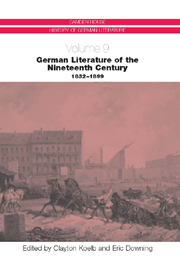Book contents
- Frontmatter
- Contents
- Illustrations
- Introduction
- Part I Contexts
- The Afterlife of Romanticism
- Parallels and Disparities: German Literature in the Context of European Culture
- Revolution and Reaction: The Political Context of Central European Literature
- Part II Movements
- Part III Genres
- Part IV Bibliographical Resources
- List of Primary Sources
- Selected Secondary Works Cited
- Notes on the Contributors
- Index
The Afterlife of Romanticism
from Part I - Contexts
Published online by Cambridge University Press: 05 February 2013
- Frontmatter
- Contents
- Illustrations
- Introduction
- Part I Contexts
- The Afterlife of Romanticism
- Parallels and Disparities: German Literature in the Context of European Culture
- Revolution and Reaction: The Political Context of Central European Literature
- Part II Movements
- Part III Genres
- Part IV Bibliographical Resources
- List of Primary Sources
- Selected Secondary Works Cited
- Notes on the Contributors
- Index
Summary
German romanticism is a complex and slippery phenomenon, resisting any straightforward cultural historical periodization or localization. From an early stage in the historiography of the movement, the precocious flourishing of Romantic ideas in the movement's early period (Frühromantik) was contrasted with the more mature literary hey-day of high Romanticism (Hochromantik) and the often wistfully self-ironic developments of late Romanticism (Spätromantik.) In fact, though, the three stages of the life of German Romanticism, broadly spanning the last decade of the eighteenth century and the first three of the nineteenth, are not synchronized in their sequence; the naïve energy of the first often jostles with the more selfconscious, even parodic, disposition of the last, even within individual works. At the same time, a number of groups vied for the proper site of the movement's center, from Jena to Heidelberg, Leipzig, and Berlin; this was a movement that moved, dissolving and reforming in a new location on more than one occasion. Nor does the sequence of phases encompass the full lifespan of the movement: there are distinct trends in eighteenthcentury Germany that prefigure Romanticism (both Empfindsamkeit and the Sturm and Drang can be seen as having proto-Romantic tendencies), and its afterlife, part of which forms the subject of this essay, is extensive and often potent.
- Type
- Chapter
- Information
- German Literature of the Nineteenth Century, 1832–1899 , pp. 23 - 44Publisher: Boydell & BrewerPrint publication year: 2005



